Category Archives: Uncategorized
Navigating India – The Journey of Ola Maps
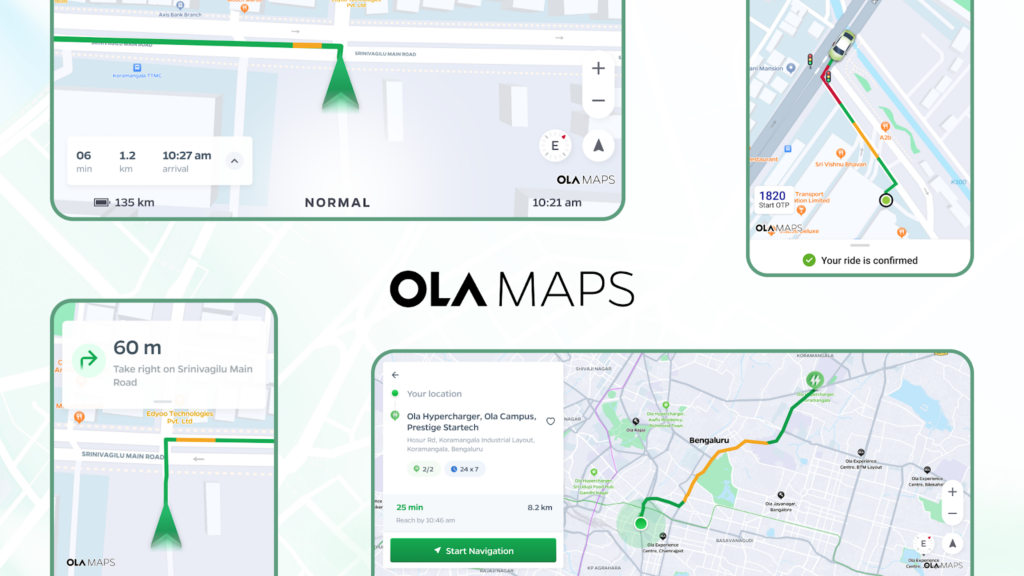
Navigating India – The Journey of Ola Maps
1. Background
At Ola, as we’ve grown from a ride-hailing app to building our own EVs to a consumer platform, we’ve come to realize that for powering mobility, Maps is not just a feature – it’s foundational to everything we do.
Maps are the beating heart of all consumer apps. They’re not just about getting from point A to point B; they’re about understanding the intricate web of streets, traffic patterns, and urban landscapes that define our cities. In 2021, we had big plans to build first to world features on our customer and partner apps that would transform the user experience, but we quickly hit a roadblock. Our reliance on Western mapping providers, for whom India wasn’t a top priority, severely limited our ability to implement these features. This limitation highlighted the crucial need for a mapping product tailored to our market.
We realized that to truly serve our users and push the boundaries of mobility, we needed a true alternative to global mapping giants—one that was not only better suited for the Indian market but also more responsive to our unique needs. This realization sparked the inception of Ola Maps.
But why build our own maps when there are existing solutions?
The answer lies in our vision for the future of commerce and transportation. We’re not just building maps for today; we’re creating the cartographic infrastructure for tomorrow’s transportation innovations. From autonomous vehicles to flying taxis, the future of mobility demands maps that are more detailed, more dynamic, and more intelligent than ever before.
Furthermore, existing maps do not fully address unique challenges related to delivering a seamless experience for Indian users and the opportunity it creates for Ola and Indian developers.
Challenges
- Incomplete Mapping Coverage: Many streets and rural areas are not mapped or poorly mapped.
- Inconsistent and Varying Street Names: Street names often have variations and inconsistencies, leading to confusion.
- Frequent Changes in Road Networks: New streets are created, and existing ones are closed frequently, leading to outdated maps.
- Traffic and Road Condition Variability: Traffic patterns are highly inconsistent, and road conditions vary significantly due to potholes and non-standard streets.
- Non-Standardized Streets: Many streets do not conform to standard measurements and layouts.
- Potholes and Road Quality Issues: Potholes and road quality can significantly affect travel time and safety.
Opportunities
- Enhanced User Experience: Providing accurate and up-to-date maps can significantly enhance navigation and travel planning, improving user satisfaction.
- Localized Features: Offering features tailored to local needs, such as multi-language support, local business listings, and culturally relevant landmarks.
- Smart Navigation Systems: Developing smart navigation systems that can suggest optimal routes based on real-time data, considering traffic, road conditions, and user preferences.
- Integration with Smart City Initiatives: Collaborating with smart city projects to integrate mapping data with other urban infrastructure, enhancing overall city management and services.
- Augmented Reality (AR) Navigation: Utilizing AR to provide intuitive and immersive navigation experiences, especially in complex urban environments.
- Real-time Predictions: Using state of the art time series models to foresee traffic congestion, road closures, and other disruptions, offering proactive routing suggestions.
- Community Engagement: Engaging with local communities to crowdsource map updates and feedback, ensuring the map remains relevant and accurate.
- Eco-friendly Routing: Implementing eco-friendly routing options that minimize fuel consumption and emissions, appealing to environmentally conscious users.
- Real-time Data Updates: Implementing real-time data updates through IoT devices, GPS tracking, and user-reported changes can keep maps current.
Addressing these unique challenges is not easy. In order to address and tap the opportunities, we are leveraging the power of AI by developing and using state of the art Krutrim models for delivering contextually relevant, accurate, safer and enhanced customer experience.
What’s even more exciting is that we’re doing this from India, leveraging the country’s vast pool of tech talent to create cutting-edge mapping technology at a fraction of the cost. This approach not only allows us to be more efficient but also ensures that our maps are built with a global perspective from the ground up.
We embarked on this ambitious journey three years ago, recognizing that to truly revolutionize mobility, we needed to own and innovate on every aspect of the maps experience that power our platform.
This post kicks off our 4-part series on Ola Maps. Here is what’s coming:
Part 1: The Foundation of Ola Maps (You are here)
Part 2: The Data Behind the Maps
Part 3: The AI Revolution in Mapping
Part 4: The Future of Maps
In the following sections in this blog, we’ll dive deeper into the technology behind Ola Maps, the challenges we’ve overcome, and how this initiative is set to transform not just Ola, but the entire mobility landscape. Stay tuned as we map out the future.
2. Ola Maps Overview – Core Foundations
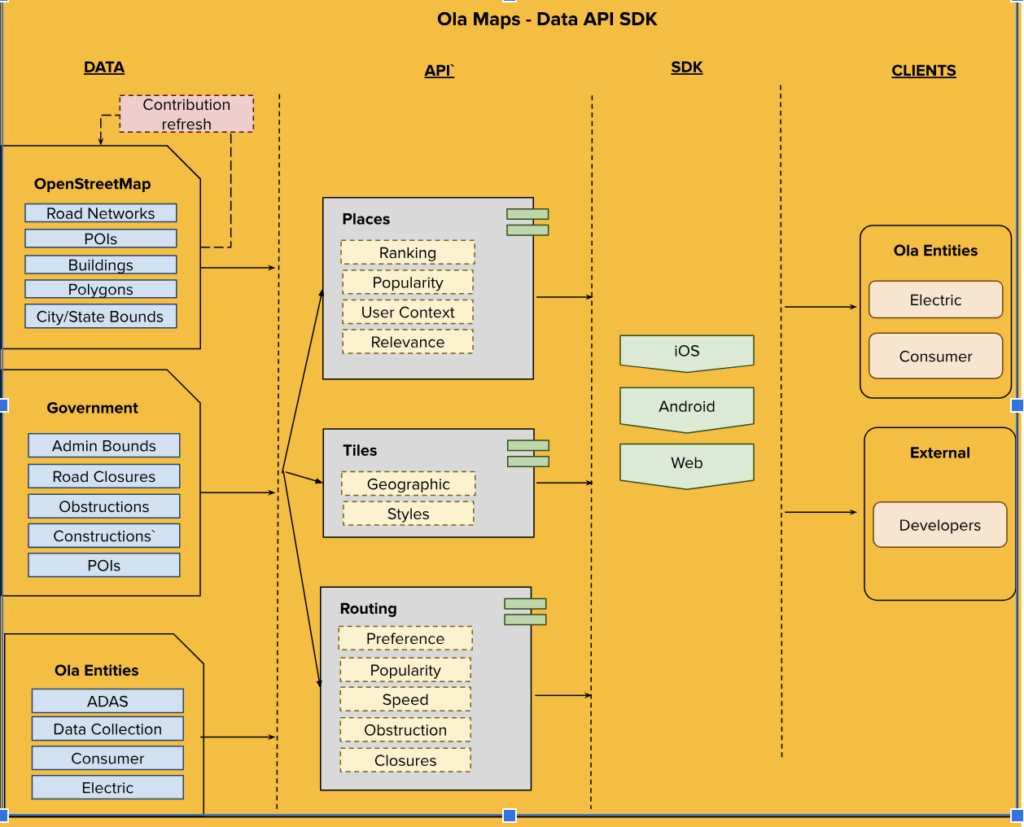
Ola Maps utilizes OpenStreetMap (OSM), government and proprietary sources to focus on building essential map features such as roads, points of interest, and traffic signals. Our base map includes detailed information on land use, water bodies, transportation networks, and more. We enhance these maps with advanced routing services that provide distance calculations, directions, and estimated time of arrival (ETA). The SDKs on Android, iOS, and web platforms, are customized for Electric and mobility clients enabling us to deliver experiences native to the respective platforms. This integration grants access to our extensive mapping services and comprehensive content.
Ola Maps has made significant contributions to the community over the years. We have used near real-time signals from the Ola Platform along with a robust sourcing strategy for Map expansion and Map maintenance. We have contributed a total of 5.43M edits shared with the community.
Open Source Models | Use Case | License |
|---|---|---|
Maplibre (Including Mapbox & Map-tiler) | Rendering (Tile rendering, Marker rendering, Feature and style rendering, real time route rendering) | BSD2_clause |
OSRM | Routing (MLD, Snap2Road) | BSD2_clause |
Pelias | Search (Autocomplete API Structure) | MIT |
OSM | Data layers* (Road,POI,polygons,cartos,Administrative areas, Traffic Signs, Traffic Signals, Buildings) | CCA |
Ola Maps is contributing back to the Community: Since inception of Ola Maps, have been actively using Open Street Maps as a foundation for map feature coverage and freshness where we have ~36% data edits contributed back to the community.
2.1 Ola Maps Ecosystem Explained:
2.1.1 Data Sources:
- OSM: OpenStreetMap data, including road geometries and POIs, is integrated.
- Government Data: Includes official data sources for enhanced accuracy.
- Ola Proprietary Data: Internal data collected and maintained by Ola collected through sensor fusion from vehicles, signals from our fleet of drivers and community feedback from Ola’s active community
2.1.2 Data Enrichment:
- Street and POI names are added in Indic languages.
- Developed and leveraged Named Entity Recognition (NER) models, semantic and syntactic parsers to further enhance accurate POI names
- POI attributes such as traffic signals, hypercharges, flyover metadata, and toll information are included.
2.1.3 Data Integration and Processing:
- All the aforementioned data sources feed into Ola Inhouse Data repository.
- Duplications and normalizations are performed to maintain unique and consistent POI names
2.1.4 Various models process this integrated data:
- Vehicle Pings from EV and Ola Consumer App: Used for predicting speed for road segments, road identifications, road closures and blockers.
- Model for Identifying Road Closures: Enhances routing accuracy by identifying temporary and permanent road closures.
- Model for Predicting Historical Speed: Analyzes historical data and leverages neural network based time series models to predict road speeds.
- Model for Generating Road Popularity: Determines road preferences based on popularity and usage data.
- Model for Search Relevancy Ranking: Enhances search results based on relevance by using state of the art mBERT (multilingual encoder) based Named Entity Recognition (NER) and Learning to Rank (LTR) models.
- Model for Identification of Contextual Searches: Understands and processes context-based search queries. This is done by syntactic and semantic search models like Bi-LSTM-CRF.
- Model for Popularity of POIs and Classification: Ranks and classifies POIs based on their popularity.
2.1.5 Core Components:
- Routing Engine: Uses the processed data and time series Neural Networks to compute optimal routes.
- Tiles: Generates map tiles for visual representation.
- Places: Manages POI data and supports search functionalities. with:
2.1.6 Consumer Applications:
The processed data and routing functionalities are accessible through:
- Maps SDK for iOS: Enables iOS applications to utilize Ola Maps services.
- Maps SDK for Android: Provides similar functionalities for Android applications.
- Consumer Interfaces:
- Ola Consumer: End-user application for navigation and other map services.
- Ola EV: Specialized interface for electric vehicle users.
This structured and integrated approach (Refer Fig.1) ensures that Ola Maps delivers accurate, real-time, and contextually relevant navigation and mapping services to its users across various platforms.
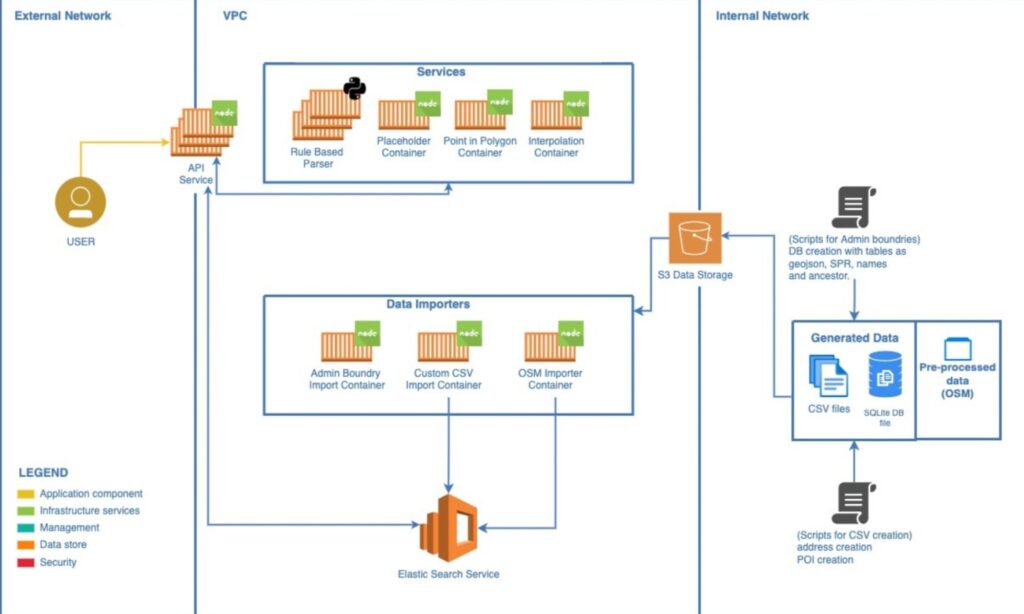
Fig 1: E2E overview of Map ecosystem where we have disparate sources being used to build Map data layers exposed via Services/SDK’s.
2.2 Ola Maps Places
Our system processes geographic datasets using various importers to populate Elasticsearch indices. These importers include:
- OSM Importer: Imports nodes and ways from Ola Maps data.
- Admin Importer: Handles importing administrative areas (localities, cities, states, regions).
- CSV Importer: Imports custom or proprietary data from CSV files.
Elasticsearch serves as our main datastore, handling query heavy lifting and powering search results.
The geocoding services comprise several components:
- API Service: Defines the Places API and interfaces with Elasticsearch and other services to execute queries.
- Placeholder Service: Manages relationships between administrative areas (e.g., cities, states) that Elasticsearch doesn’t handle well natively.
- PIP Service: Efficiently determines which administrative area polygons a given point falls within for reverse geocoding.
- Libpostal/Parser: Uses machine learning to parse addresses accurately.
- Interpolation Service: Provides estimated addresses for queries by leveraging extensive knowledge of addresses and streets, supplementing direct Elasticsearch data.
- Together, these components enable precise and efficient geospatial searches and geocoding, offering robust services for various user queries.
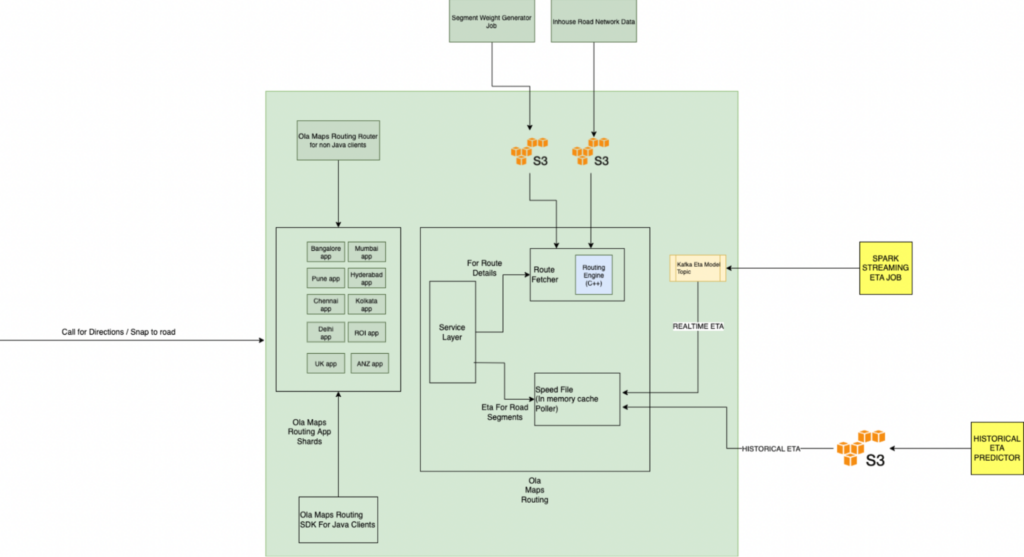
Fig 2: E2E overview of Ola Maps Places Service.
2.3 Ola Maps Routing
- Ola Maps Routing Service is sharded based on geographical boundaries
- Routing Service has 2 micro services –
- Route Fetcher – It fetches the possible routes from origin and destination by calling the Routing Engine. Routing Engine takes three inputs –
- Inhouse Road Network data which consist of data from various sources like OSM, Ola Proprietary data etch
- Weighted scores for road network which helps in generating the route preferences
- Road closures/blockage informations
- Speed Aggregator – It fetches the speed for all the possible routes for the corresponding road segments –
- Realtime Speed – Real Time speed is consumed directly from Kafka. The data into kafka is pushed by the ETA Predictor job
- Historical Speed – Historical data is present in s3 which is pushed by the Historical ETA Predictor Job
- Route Fetcher – It fetches the possible routes from origin and destination by calling the Routing Engine. Routing Engine takes three inputs –
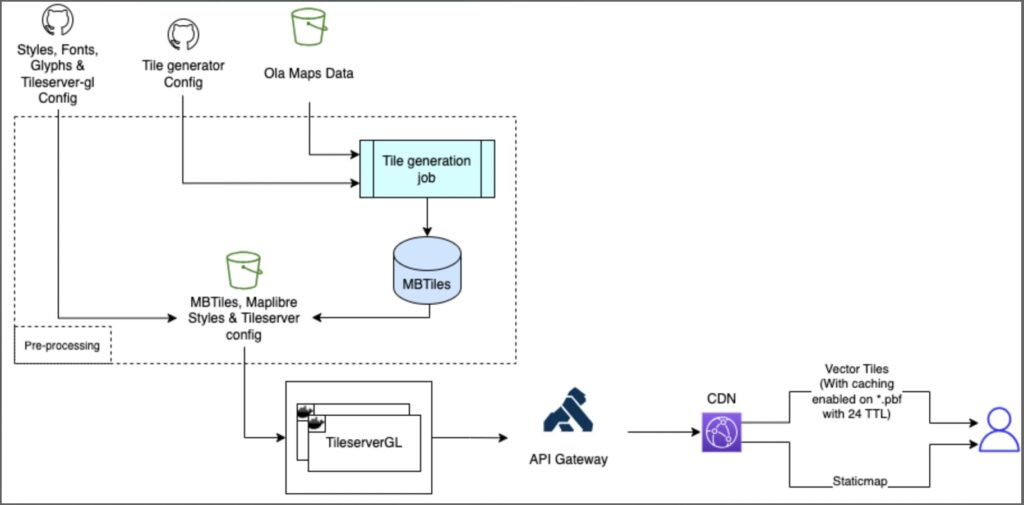
Fig 3: E2E overview of Ola Maps Routing Service
2.4 Ola Maps Tiles
In Ola Maps, each feature is described by geometries (e.g., a river’s shape) with attached attribute data (e.g., a river’s name). Geometries are represented using three elements: nodes (points), ways (lines connecting points), and relations (collections of points or ways forming a larger entity). Attributes are described as tags that can be associated with nodes, ways, or relations.
MBTiles is a file format designed for storing tilesets, allowing the packaging of many files into a single tileset. A tileset can include administrative boundaries, road networks, POIs, and other geospatial information from various sources. MBTiles is based on the SQLite database and can contain raster or vector tilesets.
Tileserver creates a map instance on the server-side using the @maplibre/maplibre-gl-native library with local styles, fonts, sprites, and MBTiles tilesets from a container. This setup is used for rendering the base map of static map images. A transparent image with markers, polylines, and a watermark is generated using the node-canvas library, which is then overlaid on the base map image to produce the final map output.

Fig 4: E2E overview of Ola Maps Tiles Service.
3. Impact of Ola Maps on Customer Experience
3.1 Ola Electric
At Ola Electric, Ola Maps is used extensively by customers for navigation with 1M search queries/week. Ola Maps was the top-rated feature in a recent NPS survey for MoveOS4. Everyday thousands of customers use Ola Maps on their scooters and the Ola Electric app for a guided commute to places in their cities.
Here’s what Ola Electric customers love about Ola Maps:
3.1.1. Traffic Updates:
< Customer Testimonials >
“I love the real-time traffic updates on Ola Maps. They are more accurate than other Maps products that I was using, which saves me a lot of time.”
“Real-time traffic updates on Ola Maps are a game-changer. I can avoid congested areas effortlessly.”
“I find Ola Maps to be more reliable in providing real-time traffic updates compared to other apps.”
3.2.2. Searches and Places location coverage and accuracy:
< Customer Testimonials >
“I’ve found a few locations on Ola Maps that were missing on other Maps. It’s great to see such accuracy!”
“Ola Maps has really impressed me with its precision. The navigation is smooth and the directions are spot on.”
“I’ve noticed that Ola Maps has captured several local spots better than other Maps products. Kudos to the team!”
“The ability to transfer locations from my phone to my scooter with Ola Maps is fantastic. It’s a big time-saver.”
3.2.3. Maps interface and integration with scooter:
< Customer Testimonials >
“This is how you share a location from WhatsApp or any other app to your scooter’s dash through the Ola companion app.I envision myself utilizing Ola Maps for navigation much more often than Google Maps, thanks to this convenient feature.”
“The user interface of Ola Maps is so clean and easy to use. It makes navigation a breeze.”
“I appreciate how Ola Maps integrates seamlessly with my Ola scooter. It’s a perfect match!”
“The feature to search the location on my phone and transfer it to my Ola scooter is incredibly convenient.”
“So far, my experience with Ola Maps has been nothing but positive. It’s intuitive and reliable.”
“Ola Maps is very user-friendly. Even my parents find it easy to use, which says a lot!”
“The integration of Ola Maps with Ola scooters is genius. It makes the whole travel experience seamless.”
3.2.4. Turn-by-turn instructions and navigation:
< Customer Testimonials >
“I just used Ola maps in my S1 Pro and it’s working very well in Pune… UI shows so much details… I would have missed the turn on Google maps but not on Ola… Seeing signals in the map UI for the first time…”
“The turn-by-turn navigation on Ola Maps is excellent. It keeps me on track without any confusion.”
“I’ve had a great experience with Ola Maps so far. It’s accurate and gets me to my destination without any hassle.”
“The detailed mapping and accurate routes on Ola Maps have made my trips so much smoother.”
Metrics on Ola Maps performance since it’s launch in MoveOS4:
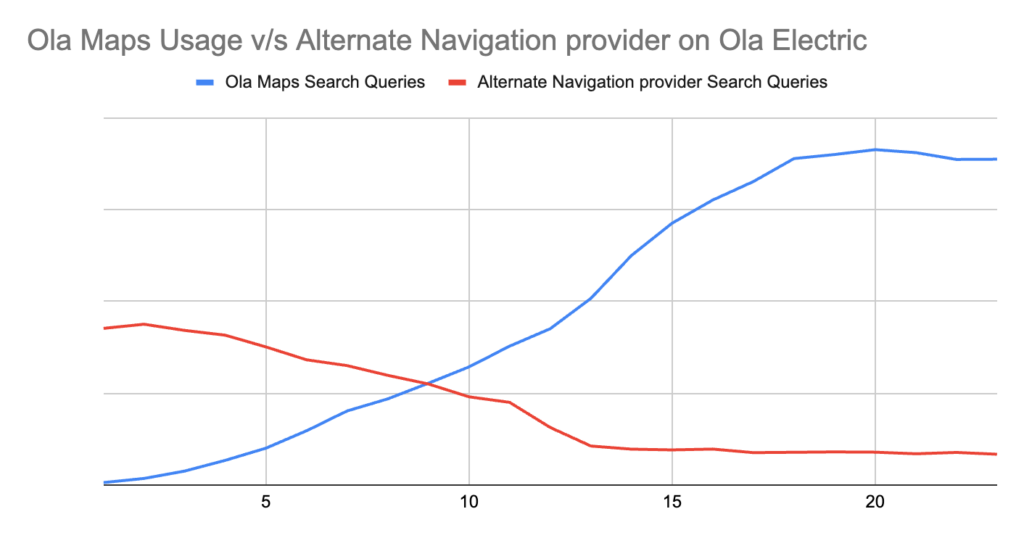




3.2 Mobility:
Our latest advancements in location technology have yielded impressive results, particularly in the accuracy of pickups and drop-offs. Here’s how we’re setting new standards in the industry:
- Pinpoint Pickups: Our enhanced pickup algorithm now outperforms the competition by a significant margin. Compared to competitors, we’ve achieved 5.3% better accuracy in matching actual pickup locations with the predicted ones and 5.1% on drops. This means less time waiting and searching, and more time getting to where you need to go.
- Lightning-Fast Results: We’ve turbocharged our search algorithm, achieving an impressive 6.67% reduction in response time. This means you’ll see available rides even faster, helping you get on the road sooner.
- Abcx – – – – – – – – –

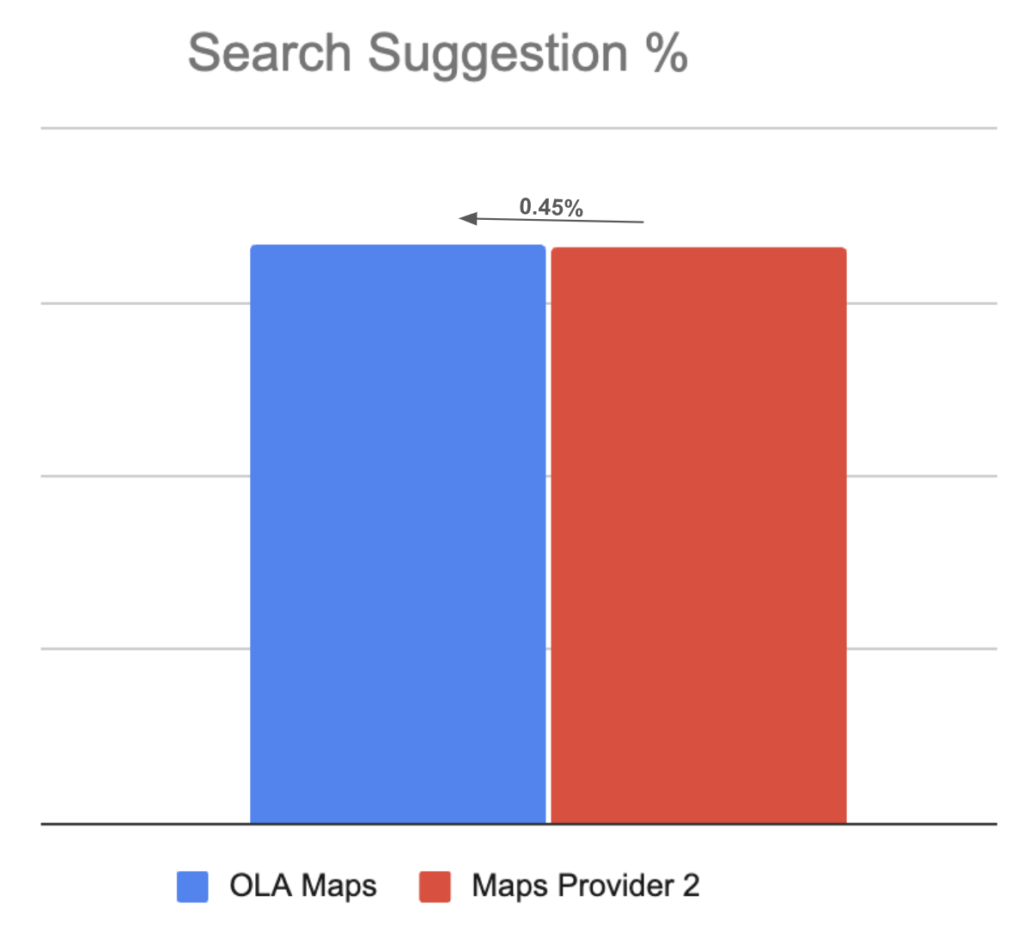

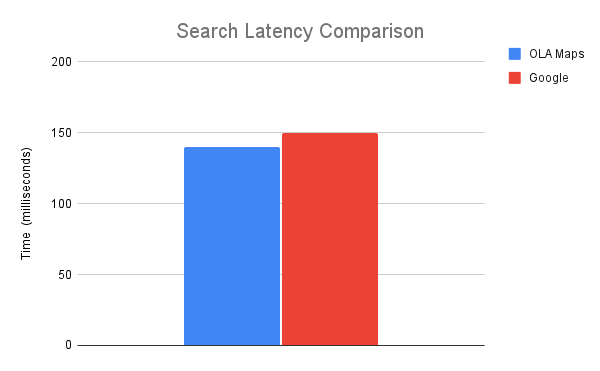
Comprehensive Pickup Information: We’ve enriched the pickup experience by providing users with more detailed information with traffic polyline and traffic lights.
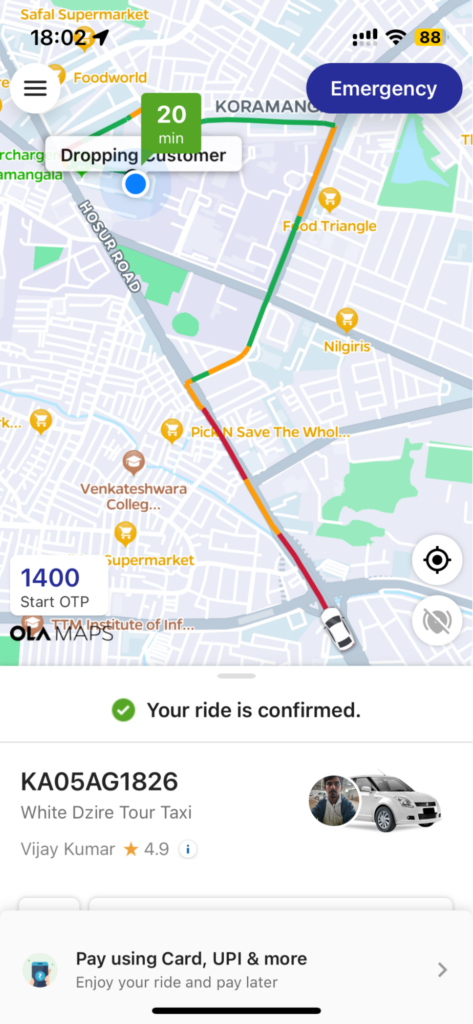
Traffic Polyline and Traffic lights

Fuzzy Search

In-App Navigation

3. Ola Maps APIs:
We are not democratizing the access to our ola maps core mapping apis for everyone though https://maps.olakrutrim.com/. These APIs are tailored to enhance location-based services with precision and efficiency for the Indian market:
- Directions API – Provides accurate routing and navigation, generating optimized routes with detailed turn-by-turn directions, travel times, and alternative routes for effective journey planning.
- Autocomplete API – Enhances search functionality by suggesting relevant completions in real-time for user queries. Ideal for connected cars, micro-mobility services, and delivery apps, it integrates location search capabilities for addresses, places, and points of interest.
- Geocoding API – Converts human-readable place names and addresses into geographic coordinates (latitude and longitude). Suitable for mapping services, logistics platforms, and location-based applications.
- Reverse Geocoding API – Translates geographic coordinates into human-readable place names, including street addresses and broader areas. Useful for applications requiring accurate location data, such as GPS tracking systems.
- Last but not least
In doing so all the things we did to build Ola Maps, our cost of maps with external providers is zero!

Mobility mapping cost

Electric mapping cost.
Stay tuned for our deep dive into the world of Ola Maps in our upcoming installments where we’ll explore the intricate data foundations, cutting-edge AI applications, and our vision for the future of mapping technology. Don’t miss these insights into how we’re reshaping the landscape of location-based services.
Annexure:
The below part is what Chandra wanted to add in the Introductory section
Furthermore, existing maps do not fully address unique challenges related to delivering a seamless experience for Indian users and the opportunity it creates for Ola and Indian developers.
Challenges
- Incomplete Mapping Coverage: Many streets and rural areas are not mapped or poorly mapped.
- Inconsistent and Varying Street Names: Street names often have variations and inconsistencies, leading to confusion.
- Frequent Changes in Road Networks: New streets are created, and existing ones are closed frequently, leading to outdated maps.
- Traffic and Road Condition Variability: Traffic patterns are highly inconsistent, and road conditions vary significantly due to potholes and non-standard streets.
- Non-Standardized Streets: Many streets do not conform to standard measurements and layouts.
- Potholes and Road Quality Issues: Potholes and road quality can significantly affect travel time and safety.
Opportunities
- Enhanced User Experience: Providing accurate and up-to-date maps can significantly enhance navigation and travel planning, improving user satisfaction.
- Localized Features: Offering features tailored to local needs, such as multi-language support, local business listings, and culturally relevant landmarks.
- Smart Navigation Systems: Developing smart navigation systems that can suggest optimal routes based on real-time data, considering traffic, road conditions, and user preferences.
- Integration with Smart City Initiatives: Collaborating with smart city projects to integrate mapping data with other urban infrastructure, enhancing overall city management and services.
- Augmented Reality (AR) Navigation: Utilizing AR to provide intuitive and immersive navigation experiences, especially in complex urban environments.
- Real-time Predictions: Using state of the art time series models to foresee traffic congestion, road closures, and other disruptions, offering proactive routing suggestions.
- Community Engagement: Engaging with local communities to crowdsource map updates and feedback, ensuring the map remains relevant and accurate.
- Eco-friendly Routing: Implementing eco-friendly routing options that minimize fuel consumption and emissions, appealing to environmentally conscious users.
- Real-time Data Updates: Implementing real-time data updates through IoT devices, GPS tracking, and user-reported changes can keep maps current.
Addressing these unique challenges is not easy. In order to address and tap the opportunities, we are leveraging the power of AI by developing and using state of the art Krutrim models for delivering contextually relevant, accurate, safer and enhanced customer experience.What’s even more exciting is that we’re doing this from India, leveraging the country’s vast pool of tech talent to create cutting-edge mapping technology at a fraction of the cost. This approach not only allows us to be more efficient but also ensures that our maps are built with a global perspective from the ground up.

On Linkedin, Microsoft and their wokeness
As an Indian institution, Ola is for genuine actions on diversity. We run one of the largest WOMEN ONLY automotive plant. Not 1 out of 10 lines, or a small section, but the whole plant! Almost 5000 women now and will grow to tens of thousands in the coming years. And regarding gender inclusivity, we don’t need lectures from western companies on how to be inclusive. Our culture didn’t need pronouns to be inclusive for thousands of years. On a personal note, I had visited Ayodhya last year and learnt about how transgenders had been accorded special respect in our culture from ancient times! Here’s a short video from our national broadcaster DD on this –
On the other hand, the pronouns issue I wrote about is a woke political ideology of entitlement which doesn’t belong in India. I wouldn’t have waded into this debate but clearly Linkedin has presumed Indians need to have pronouns in our life, and that we can’t criticise it. They will bully us into agreeing with them or cancel us out. And if they can do this to me, I’m sure the average user stands no chance. As a founder and CEO, this western DEI system has a major impact on my business if it grows an entitlement mindset in our professional lives and I will fight it.
This situation brings me to the need for us to build our own Indian tech platforms. I’m not against global tech companies. But as an Indian citizen, I feel concerned that my life will be governed by western Big Tech monopolies and we will be culturally subsumed as the above experience shows. This is not about Ola or any of my companies. Ola is too small to make any impact against this. I want to confront this forced ideology as a free thinking Indian and do what I can in my capacity. So here are the actions I’m taking. Putting my money where my mouth is.
- While we can’t do anything about LinkedIn’s monopoly overnight, I’m making a commitment to work with the Indian developer community to build a DPI social media framework. DPIs like UPI, ONDC, Aadhaar etc are a uniquely Indian idea and is even more needed in the world of social media. The only “community guidelines” should be the Indian law. No corporate person should be able to decide what will be banned. Data should be owned by the creators instead of being owned by the corporates who make money using our data and then lecture us on “community guidelines”!
- Since LinkedIn is owned by Microsoft and Ola is a big customer of Azure, we’ve decided to move our entire workload out of Azure to our own कृत्रिम cloud within the next week. It is a challenge as all developers know, but my team is so charged up about doing this.
- Any other developer who wants to move out of Azure, we will offer a full year worth of free cloud usage. As long as you don’t go back to Azure after that! Mail us on exitazure@olakrutrim.com. Offer is perpetually open!
– Bhavish
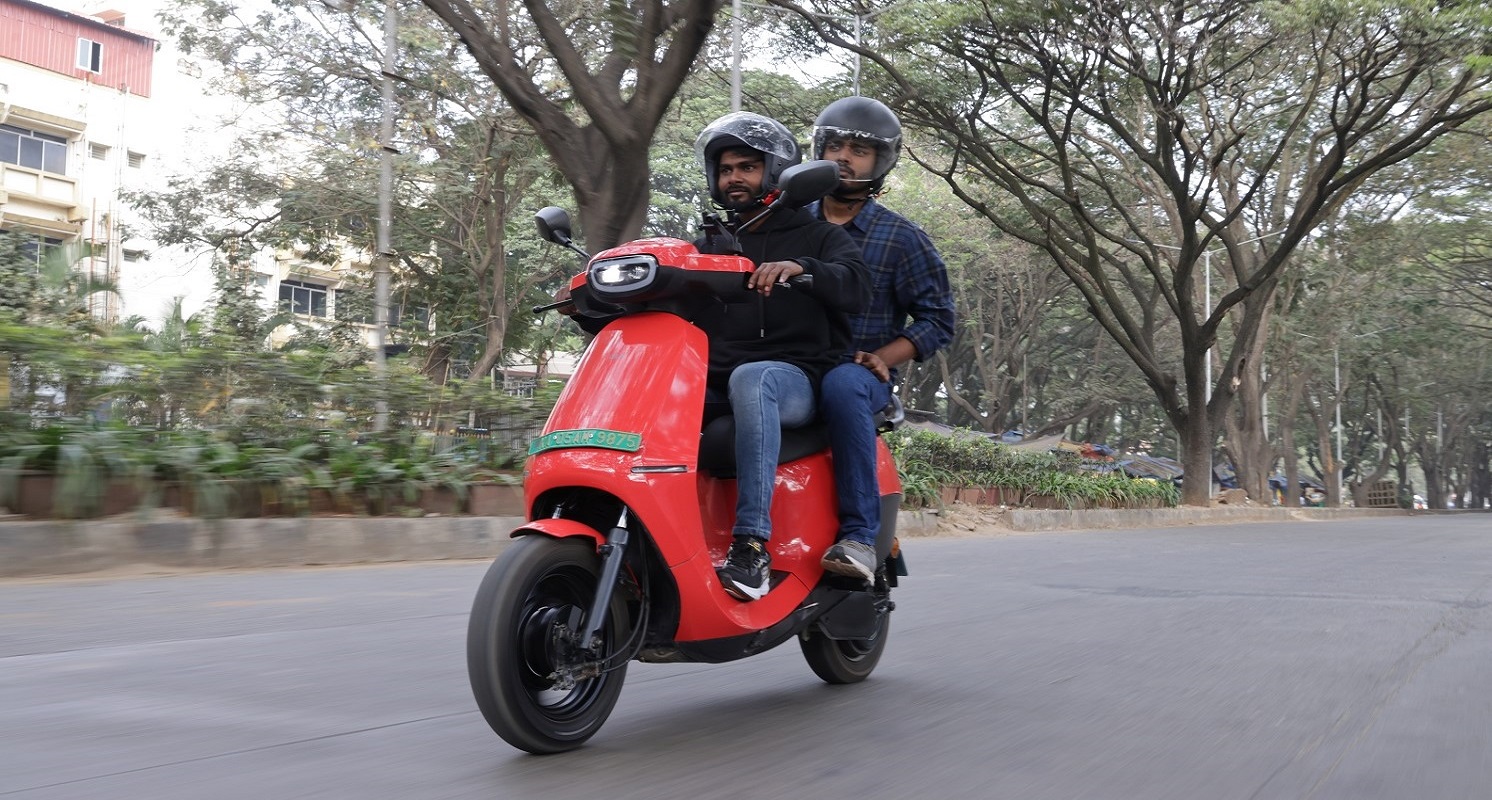
Ola Mobility accelerates electrification momentum,
announces launch of e-Bike service in Delhi and Hyderabad
With deployment of these vehicles, Ola will have the largest EV 2W fleet in the country
Bangalore, January 26, 2024: Ola, India’s largest ride-hailing platform, today announced the launch of its e-Bike service in Delhi and Hyderabad, while the company will expand and increase deployment of e-Bikes in Bangalore following a massive pilot success. In line with the company’s vision and growth strategy of serving 1 Billion Indians and nationwide penetration with electrification, Ola plans to deploy 10,000 e-vehicles over the next 2 months across these cities. With the deployment of these vehicles, Ola will have the largest EV 2W fleet in the country, and the company will double down and scale up the e-Bike services throughout India by the end of this year.
With prices as low as INR 25 for 5 km, INR 50 for 10 km, INR 75 for 15 km, the Ola eBike service will be the most affordable, sustainable, and convenient solution to commute within the cities.
Commenting on the launch, Hemant Bakshi, CEO, Ola Mobility , said: “Electrification is the biggest lever to unlock affordability in the mobility space. At Ola, driving affordable mobility through electrification is our priority and in line with our vision to serve 1 billion Indians. Following the massive success of our Bangalore e-Bike taxi pilot, we have proven its sustainable value proposition for all ecosystem participants – the consumer (lower price), the driver (higher earnings), and Ola (new category and revenues), and now look at mass deployments across Bangalore, Delhi and Hyderabad and build a larger market for e-Bike taxis in India. With our focus on innovation, and accessibility, our e-Bike taxi initiative will also serve as a multi-work opportunity for gig-economy workers on the Ola platform and pave the way for the future of commerce.”
In September 2023, Ola revolutionized urban mobility in Bangalore with a pilot launch of the e-Bike taxi service. The pioneering move offered the most affordable electric two-wheeler rides in India, and a substantial 40% market expansion in the category within three months. To date, it has accomplished more than 1.75 million rides. In addition, Ola also set up 200 charging stations in Bangalore to service its ebike fleet. It will also set up an extensive charging network in all markets it operates in.
Ola recently announced that its India Mobility Business has turned EBITDA positive in FY 23, one of the few Indian internet companies to achieve this feat. The company announced an aggressive growth focus on ride-hailing, financial services, logistics, and e-commerce. With a vision to serve a billion Indian consumers and empower 10 million partners economically, Ola is all set to reimagine and redefine mobility.
Test
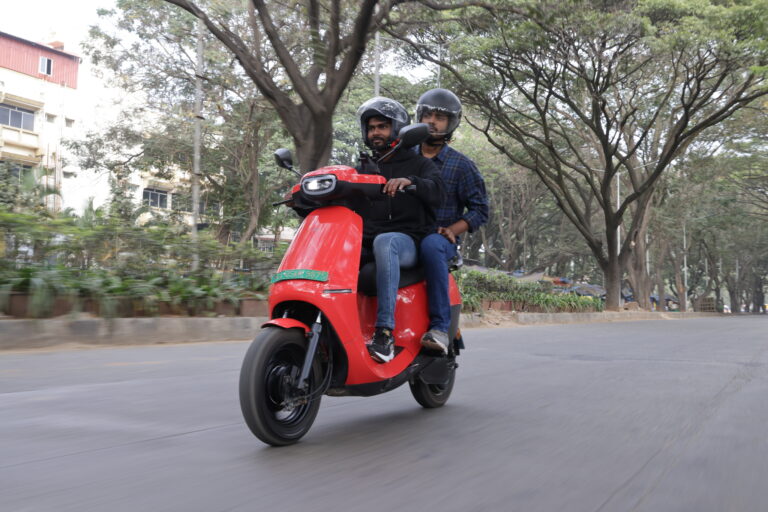
Ola Mobility accelerates electrification momentum, launches E-Bike service in Delhi and Hyderabad
To deploy 10,000 e-vehicles over the next 2 months across these cities
With deployment of these vehicles, Ola will have the largest EV 2W fleet in the country
Bangalore, January 26, 2024: Ola, India’s largest ride-hailing platform, today announced the launch of its e-Bike service in Delhi and Hyderabad, while the company will expand and increase deployment of e-Bikes in Bangalore following a massive pilot success. In line with the company’s growth pillars- nationwide penetration with electrification, Ola plans to deploy 10,000 e-vehicles over the next 2 months across these cities. With the deployment of these vehicles, Ola will have the largest EV 2W fleet in the country.
With prices as low as INR 25 for 5 km, INR 50 for 10 km, INR 75 for 15 km, the Ola eBike service will be the most affordable, sustainable, and convenient solution to commute within the cities. The service has been launched as part of Ola’s commitment to provide innovative, sustainable solutions to meet the evolving mobility needs of the customers. The service will be scaled in cities across the country in the next few months.
Commenting on the launch, Hemant Bakshi, CEO, ANI Technologies, said: “Electrification is the biggest lever to unlock affordability in the mobility space. At Ola Mobility, driving affordable mobility through electrification is our priority and in line with our vision to serve 1 billion Indian consumers. Following the massive success of our Bangalore e-Bike taxi pilot, we have proven its sustainable value proposition for all ecosystem participants – the consumer (lower price), the driver (higher earnings), and Ola (new category and revenues), and now look at mass deployments across Bangalore, Delhi and Hyderabad and build a larger market for e-bike-taxis in India. With our focus on innovation, and inclusivity, our e-bike taxi initiative will also serve as a multi-work opportunity for gig-economy workers on the Ola platform and pave the way for the future of commerce.”
Ola recently announced that its India Mobility Business has turned EBITDA positive in FY 23, one of the few Indian internet companies to achieve this feat. The company announced an aggressive growth focus on ride-hailing, financial services, logistics, and e-commerce. With a vision to serve a billion Indian consumers and empower 10 million partners economically, Ola is all set to reimagine and redefine mobility.
In September 2023, Ola revolutionized urban mobility in Bangalore with a pilot launch of the e-Bike taxi service. The pioneering move offered the most affordable electric two-wheeler rides in India, and a substantial 40% market expansion in the category within three months. To date, it has accomplished more than 1.75 million rides. In addition, Ola also set up 200 charging stations in Bangalore to service its ebike fleet.
The e-bike service is one of the many steps Ola has taken over the last few months to enhance the ride-hailing experience in India. It has recently launched its premium service Prime Plus in Bengaluru, Mumbai, Pune, and Hyderabad to ensure a seamless commute experience for customers with professional drivers and complete ride assurance, eliminating any cancellations or operational hassles.

The journey so far and the path ahead
We are proud that we are building a business in shared mobility in India. The impact we can make and the lives we can touch is inspiring. We are happy that the quality of our business has come a long way and are proud to share a view of where we are today and what we intend to achieve going forward.
There was a time when autos and public transport were the most popular mode of transport across India. This time was, Before Ola. It was a time when cabs were not easily accessible and cab owners struggled to find riders. Traveling from one place to another wasn’t easy.
In this context, Ola pioneered the concept of shared mobility in India and made it accessible to every Indian. The introduction of Ola Cabs allowed users to book rides conveniently through a mobile app, bringing a new level of efficiency and ease to urban transportation. We remained at the forefront of mobility transformation in India, and we did this while leveraging innovative services, technology, a focus on affordability, and expansion across the country. All of which have collectively shaped a more convenient and efficient transportation landscape in the country.
Over the years, Ola became synonymous with ride hailing – customers would often exclaim while on the move – “Ola karlo?” This phrase makes us proud – we are no longer a noun, we are a verb!
We learnt in our early days that supply on the platform was critical, and by providing a compelling offering to our partners, we could build a healthy and vibrant ecosystem. We have been dedicated to providing a fulfilling experience to our partners, knowing that we succeed only when they thrive.
We gradually expanded outside of cabs and launched a set of newer categories and businesses including but not limited to autorickshaw, bikes, outstation, rentals. The brand’s strong association with mobility remains a testament to its success in shaping and dominating the narrative of on-demand transportation in India.
Inarguably, COVID has been one of the biggest crises in modern history, disrupting and changing the contours of almost all industries. Like many others, we weren’t immune to this disruption either. The pandemic saw us facing lockdowns, social distancing measures, and a steep decrease in travel. In parallel, there was a migration of partners to hometowns, even as work from home became more of the norm in a covid-stricken world.
However, we were resilient and our truly entrepreneurial culture empowered us to convert the crisis into an opportunity – the changes we made in our operating model then continue to help us even today. As a result of our trials and perseverance, our new business model has come together. The moves we made during and after the pandemic have now made our operating model not only scalable but also profitable.
It is truly humbling to witness the deep-rooted presence we have established in India. We have created a vast and fully integrated ecosystem of partners and riders that not only creates value for the riders on our platform but also acts as an economic enabler for our partners. More importantly, we are truly inspired by the change that we have engendered and the positive impact that we have brought into the lives of those who are part of our ecosystem.

In FY23 we challenged ourselves – to not just grow and scale, but to do this profitably. While our revenue continued to grow at a strong clip of 58%, we became EBITDA positive in the India mobility business. One of the few consumer internet businesses in India to be profitable at this level.


*Note: EBITDA numbers for continuous business
This is an incredible milestone. Often we were challenged if we could ever be profitable. In the true Ola way, we have let our actions speak louder than words.
India’s growth is unstoppable! A young and digital native demographic, India is well on its way to achieving a USD 5 Trillion economy and becoming the 3rd largest economy by 2027-2028. We will see growth across the spectrum. Number of affluent consumers will grow rapidly, it is estimated that the total number of affluent households in India (annual income > INR 20 Lakhs) will grow by 13 million by 2030. These consumers will expect a step jump in the quality of services offered to them – no different from any other part of the world. At the same time there will be a large upsurge in the consuming class. India will add ~45 million households to her middle class. We will serve our customers at both ends of the spectrum.
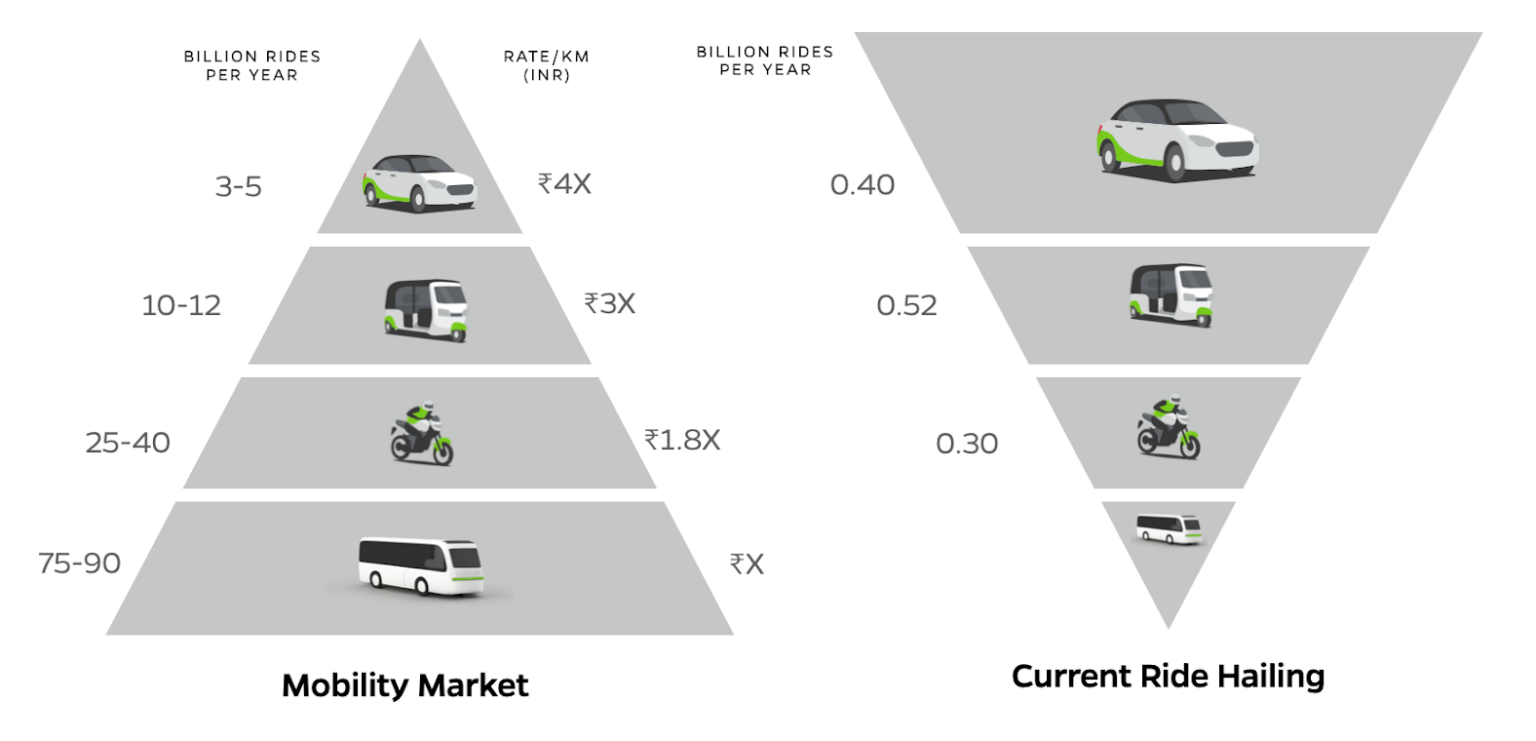
The potential for us to shape the future is immense. We have the right starting point and we are determined to build on this going forward.
Paving our path ahead
We are organizing ourselves into three business units to allow focused management, streamlined operations, and more agility.
- Ride Hailing and mobility
- Financial Services
- Logistics & E-Commerce
1. Ride Hailing: We have a clear, cohesive and compelling plan to participate in India’s growth story. In mobility, our strategy is built on three pillars – Premiumization and Penetration by leveraging Electrification and Technology.
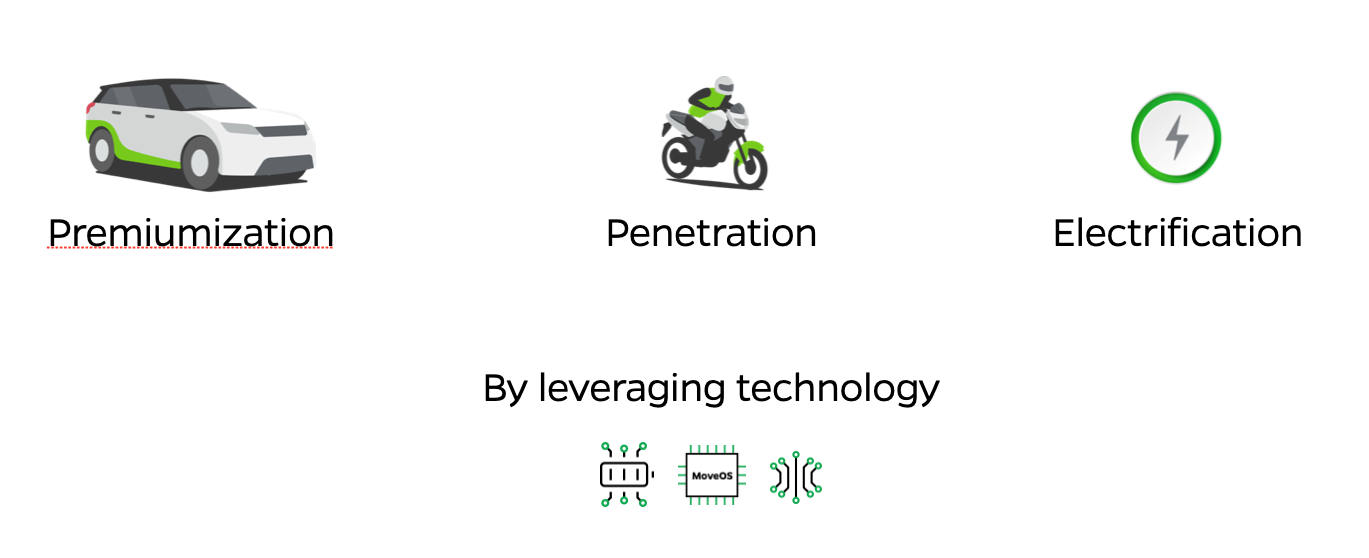
a. Premiumization: Ola aims to offer superior service to its riders and partners, thereby providing opportunity to premiumize its offering. We are actively working towards this and our Prime+ initiative is an example which we already see on ground.
Prime+: We launched Prime+ to offer our discerning customers premium services with better partners, superior in-ride experience, faster allocation and no cancellations. Although the selection process was stringent, over 16k partners have been on-boarded across 7 cities and 1.9 Mn riders have availed Prime+ service so far. We are continuously building on this service and will make it available to many more consumers in the near future.
Driving premiumization of 4W category through Prime Plus launch
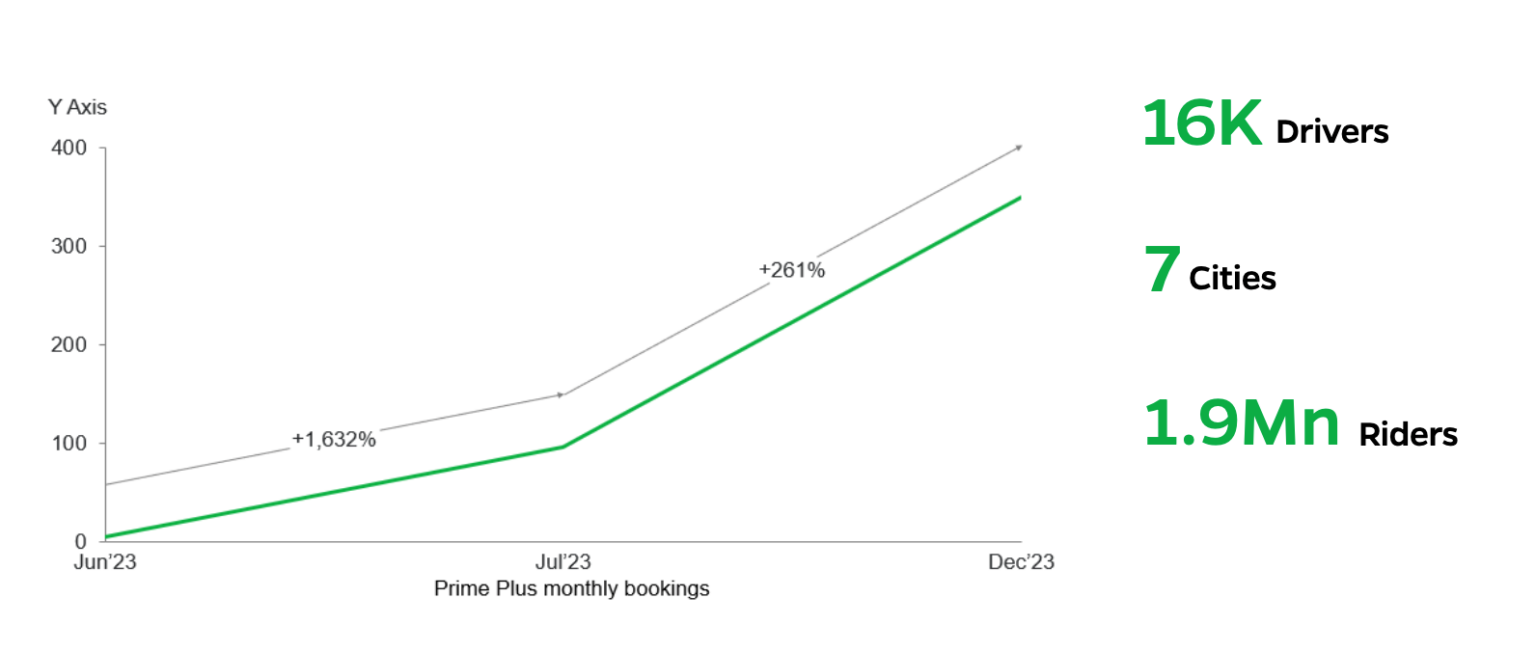
We will continue to build premium services and experiences on our platform. A Loyalty programme that unlocks exclusive services and introduction of a Luxury category are on the anvil.
b. Penetration through Electrification: Electrification is the biggest lever to unlock penetration. We will leverage Electrification to disrupt the mobility space by offering the most affordable rides across all segments
(Typical Daily Rider Cost comparison – INR)

We have already seen early success of this strategy in e-bikes launched in Bangalore. In September 2023, Ola revolutionized urban mobility in Bangalore with the launch of our e-bike service. Our service offered the most affordable electric two-wheeler rides in India, priced ~30% lower than those of our competitors. This pioneering move led to a substantial 40% market expansion in the category within three months. To date, we’ve accomplished more than 1.75 million rides. In addition, we have also set up 200 charging stations in Bangalore to service our fleet.
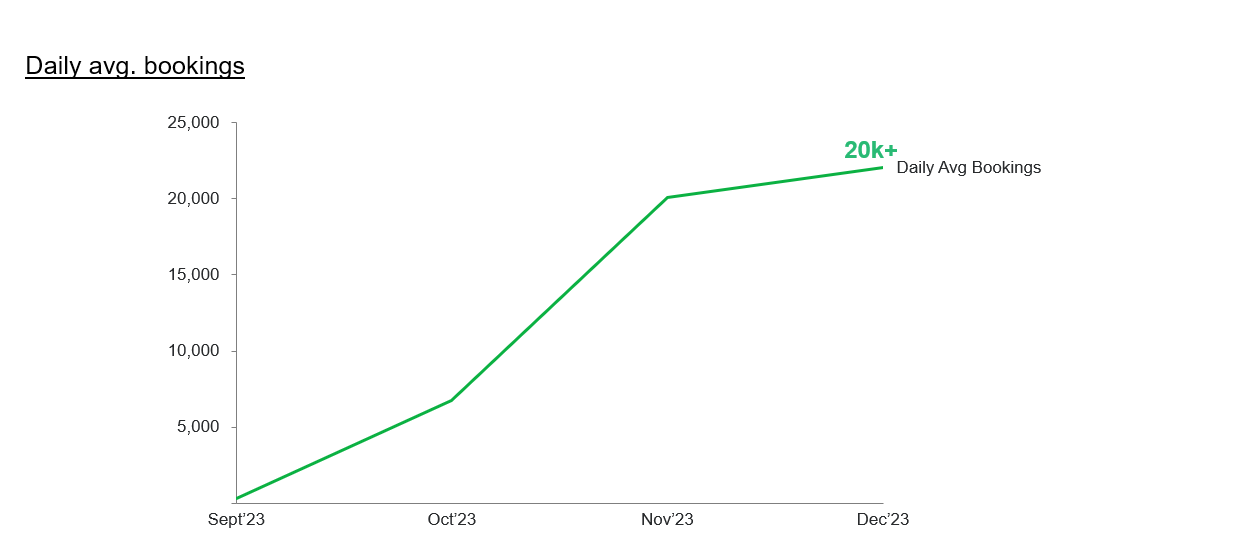
This model also allows us to address a multi-work opportunity. Our partners can deliver on other use-cases during their slack period. We have started with parcels, food and grocery but will grow into additional categories as well. We will scale our e-bike business nationally by the end of this year, we expect to complete 0.5 Bn rides this year. At the same time we will establish a national Charging Network to support this category.
This is just the first step in our goal to transform mobility in India. Through the electrification of 3W and 4W categories we will drive penetration and upgradation across all segments.
c. Technology: Ola consistently channels investments into advancing its technological capabilities through a diverse array of initiatives. This commitment extends across enhancing customer and partner services, as well as optimizing platform efficiency for an overall elevated experience. Ola Maps and AI powered Customer Care are recent examples.
Ola Maps: In FY23, we successfully transitioned to our proprietary in house Ola Maps which led to better search results & improved wait time estimate accuracy. With our latest improvements in our places and POI (Points of interest) data, and routing algorithm we now have in-house capabilities leading to faster time-to-market, and response to customer / partner requests.
AI powered customer care: In FY23, we strategically integrated Artificial Intelligence into our Care operations, aiming to elevate the overall customer and partner support experience. The results were remarkable, with a noteworthy 69% improvement in resolution turnaround time. This underscores our commitment to leveraging cutting-edge technology for the benefit of our valued users and partners.
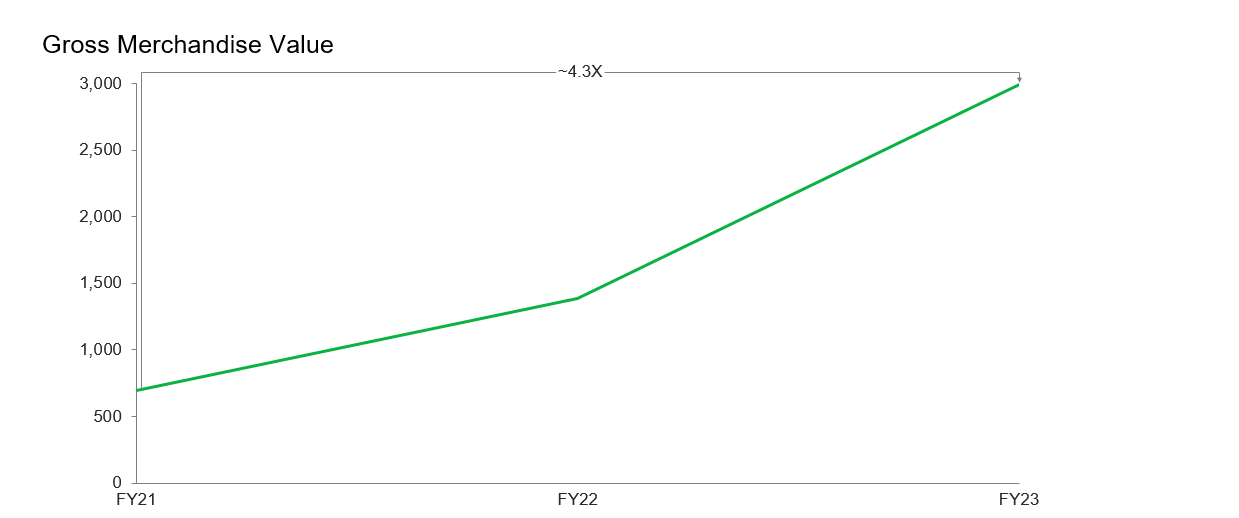
Ola Financial Services | ~4X growth in GMV across lending, asset financing and insurance
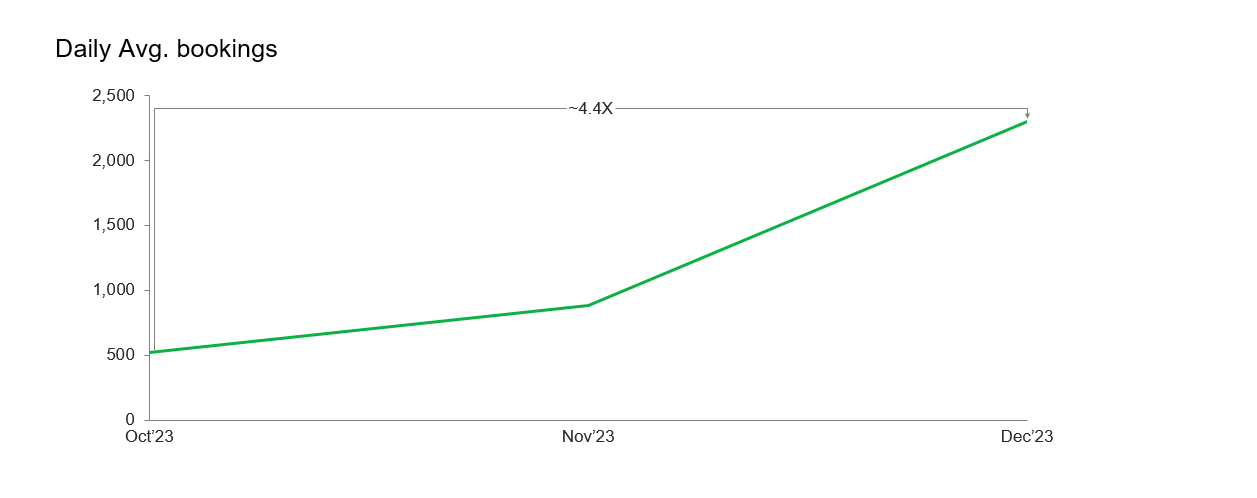
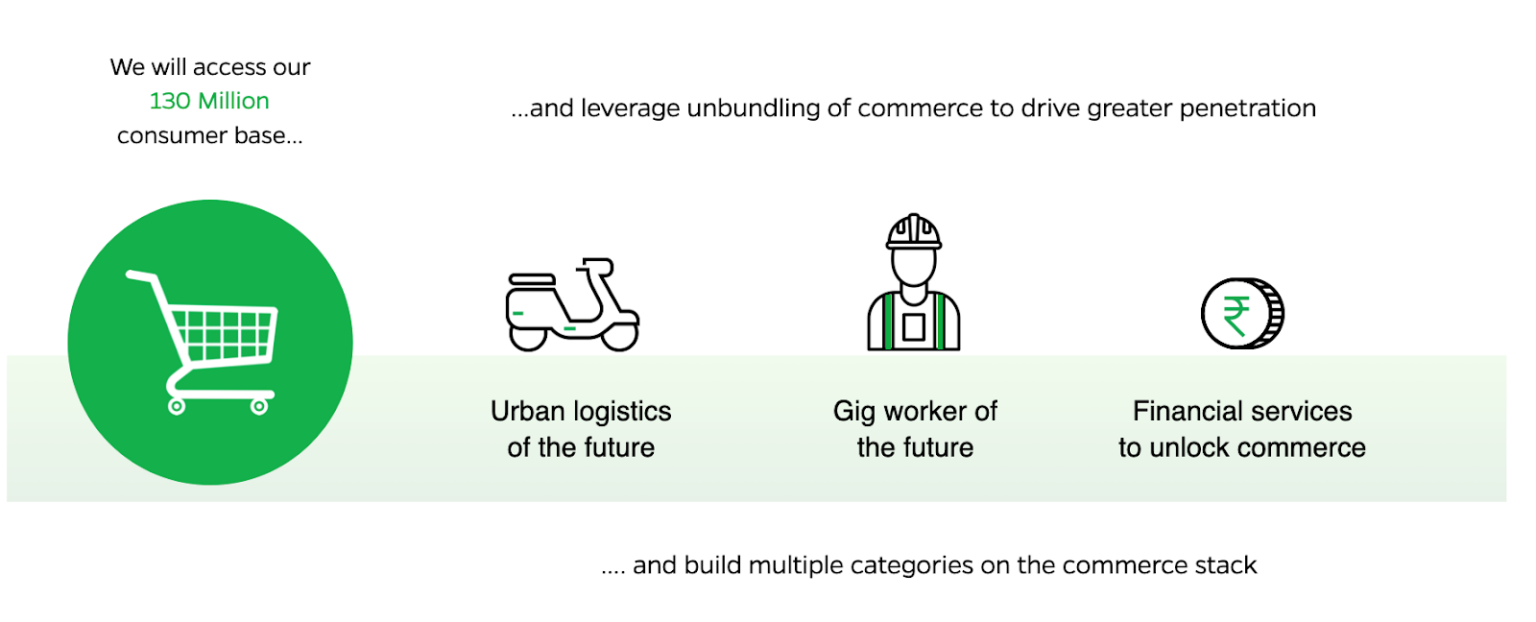
Our aspirations in mobility and commerce are ambitious and exciting. At the same time, we remain confident of our ability to achieve them. We have built a set of strong assets and they will serve as a bedrock for our growth. The assets we will lean on:
- Our 130 Mn+ individual consumers
- Our deep and close partnership with Electric OEMs especially Ola.
- Our access to the latest AI capabilities through our partnership with Ola Krutrim.
- Our financial services business across lending, insurance, and wallet
Ola culture = Customer-centricity + Innovation + Passion for Perfection
Ola has prided itself since inception of being a ‘Technology-first’ business which employs technology to solve problems and challenges that confront India’s shared mobility industry. Hence, Ola encourages a strong innovation culture at the workplace that has served it well in the past. We are further institutionalizing this with a strong “customer-first” culture. In line with the same, we launched ‘Apna Ola’ recently and have already seen strong traction from our partners. Apna Ola improves Transparency, builds Trust and increases Benefits for our partners. But ‘Apna Ola’ is just the beginning. There is a lot more to come. Our manifesto continues to guide us and drive us to our goals.

Onwards & upwards,
Hemant & Bhavish

Here are a few instructions that you need to follow with your new Ola S1 Electric scooters
यहां कुछ निर्देश दिए गए हैं जिनका आपको अपने नए Ola S1 इलेक्ट्रिक स्कूटर के साथ पालन करना होगा।
- You can charge your scooters in Ola Hypercharger/Fast Chargers only if your vehicle temperature is less than 30°C. If your vehicle temperature is more than 30°C, then do not connect to the Fast Charger, wait for the vehicle to cool down, and then put the vehicle on charge ONLY.
आप अपने स्कूटर को Ola Hypercharger/Fast Chargers में तभी चार्ज कर सकते हैं जब आपके वाहन का तापमान 30 डिग्री सेल्सियस(30°C) से कम हो। यदि आपके वाहन का तापमान 30 डिग्री सेल्सियस(30° C) से अधिक है, तो फास्ट चार्जर से कनेक्ट न करें, वाहन के ठंडा होने तक प्रतीक्षा करें और उसके बाद ही वाहन को चार्ज पर लगाएं। - Always ride your vehicle only in ECO Mode. This will give you more range, hence more bookings and more earnings!
अपने वाहन को हमेशा ECO मोड में ही चलाएं। इससे आपको अधिक रेंज मिलेगी, इसलिए अधिक बुकिंग होगी और अधिक कमाई होगी! - Whenever there is an issue with your scooter like boot/trunk not opening, handle lock etc., kindly restart the scooter once. If the issue is still not solved, then reach out to your account manager. Also, watch the video on how to restart your scooter: https://www.youtube.com/embed/Jikg_8d_Lkg
जब भी आपके स्कूटर में बूट/ट्रंक न खुलने, हैंडल लॉक आदि जैसी कोई समस्या हो, तो कृपया स्कूटर को एक बार पुनः चालू करें। यदि समस्या अभी भी हल नहीं हुई है, तो अपने अकॉउंट मैनेजर से संपर्क करें। इसके अलावा, अपने स्कूटर को रीस्टार्ट करने के तरीके पर वीडियो देखें:
- Here is the list of Ola Hypercharger/Fast Chargers in Delhi and NCR. Navigate to the nearest charger to charge your scooters, and get your Ola Electric Scooter charged!
यहां दिल्ली और एनसीआर में स्थित Ola Hypercharger/Fast Chargers की सूची दी गई है। अपने स्कूटर को चार्ज करने के लिए निकटतम चार्जिंग लोकेशन पर जाएँ, और अपने Ola इलेक्ट्रिक स्कूटर को चार्ज करें!
| Hyperchargers / Fast Chargers Location | Google Map link |
| Ola Hypercharger, BPCL Station, Vasant Kunj | Ola Hypercharger, BPCL Station, Vasant Kunj |
| Ola Hypercharger, BPCL Station, Anand Vihar | Ola Hypercharger, BPCL Station, Anand Vihar |
| Ola Hypercharger, BPCL Station, Barakhamba | Ola Hypercharger, BPCL Station, Barakhamba |
| Ola Hypercharger, HPCL Station, Pitam Pura | Ola Hypercharger, HPCL Station, Pitam Pura |
| Ola Hypercharger, HPCL Station, Rohini | Ola Hypercharger, HPCL Station, Rohini |
| Ola Fast Charger Jasola Vihar | Ola Fast Charger Jasola Vihar |
| Ola Fast Charger Phase-2, Noida | Ola Fast Charger Phase-2, Noida |
| Ola Fast Charger Sector C, Vasant Kunj | Ola Fast Charger Sector C, Vasant Kunj |
| Ola Fast Charger Nanak Pura | Ola Fast Charger Nanak Pura |
| Ola Fast Charger Karkardooma | Ola Fast Charger Karkardooma |
| Ola Fast Charger President’s Estate | Ola Fast Charger President’s Estate |
| Ola Fast Charger Mandi House | Ola Fast Charger Mandi House |
| Ola Fast Charger Nangli Vihar Extension | Ola Fast Charger Nangli Vihar Extension |
| Ola Fast Charger Vivek Vihar | Ola Fast Charger Vivek Vihar |
| Ola Fast Charger New Mustafabad | Ola Fast Charger New Mustafabad |
| Ola Fast Charger Wazirabad | Ola Fast Charger Wazirabad |
| Ola Fast Charger Sector 18, Noida | Ola Fast Charger Sector 18, Noida |
| Ola Fast Charger Mayur Vihar Phase I | Ola Fast Charger Mayur Vihar Phase I |
Ola x Paytm UPI Offer
Exciting Offer Details
- Here’s a guarantee: Cashback up to Rs. 100! (Minimum cashback is Rs. 3]
- Everyone’s invited—open to all users!
- Just hop on an Ola ride with a minimum value of Rs. 49.
- Users can enjoy this offer up to 3 times a month (on the first three Paytm UPI transactions).
- Validity: 1 month
- Users get an instant scratch card as a reward.
Terms & Conditions:
- This offer is applicable only when users Pay on Ola for ₹49 or more.
- Users can use these 3 times during the offer period and 3 times in a month.
- Just remember to use Paytm UPI while paying on Ola to unlock the offer.
Offer Timeline:
- The offer begins on 16th December 2023
- On the user’s first transaction, the offer will be automatically activated!
- Ensure the first Ola payment is made before 31-12-2023, 23:59:00, to enjoy cashback up to ₹100.
Rewards:
- Each reward will be received within 10 days of completion of the transaction on which the
reward is eligible. - All scratch cards issued from this offer will expire after 7 days
- Paytm reserves its absolute right to withdraw and/or alter any terms and conditions of the offer
at any time without prior notice. - Any valid concerns related to cashback not covered in T&Cs shall be handled by Paytm’s
customer care/CST.
Enjoy your rides and cashback delights!
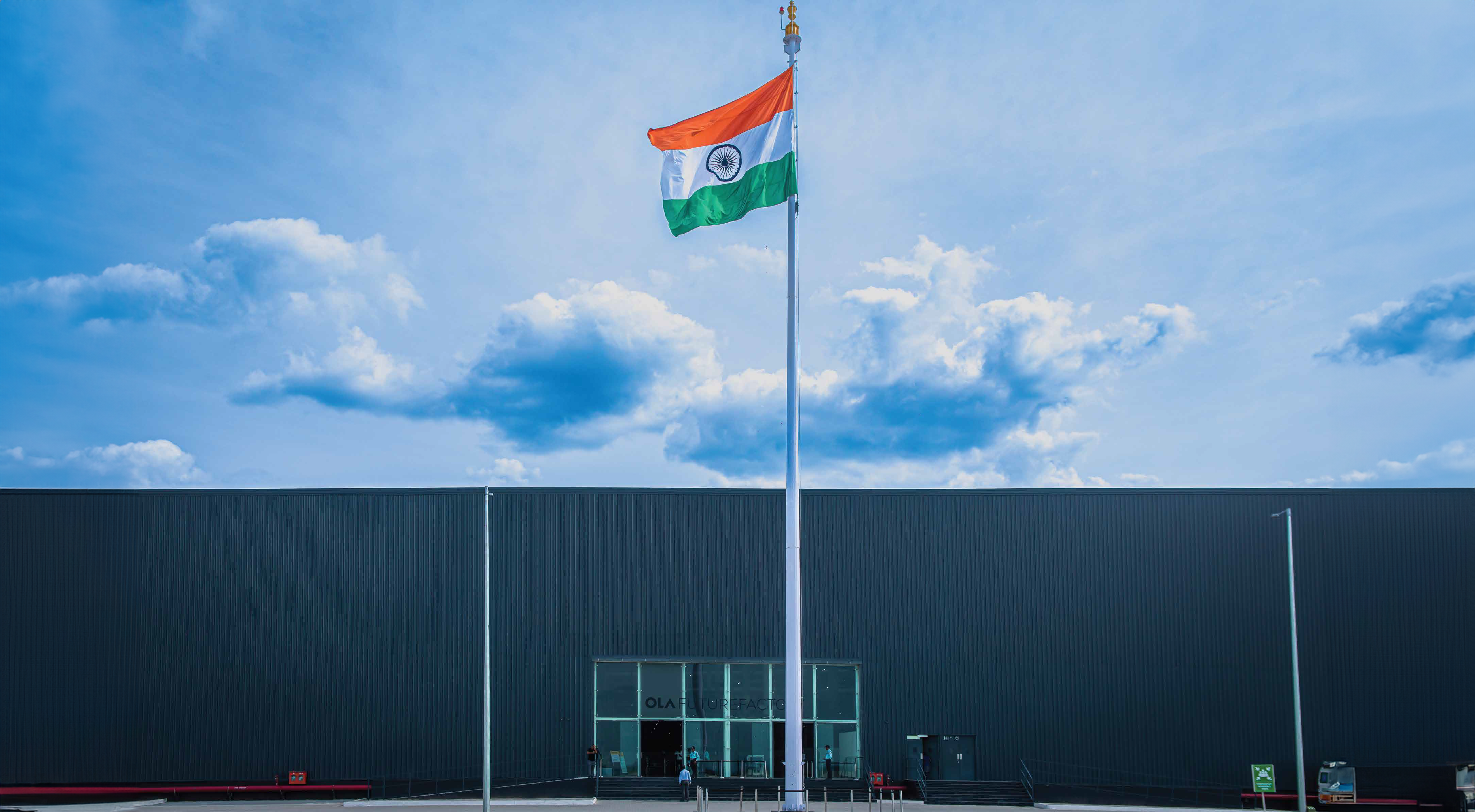
A note on our 13th Foundation Day
Today marks Ola’s 13th foundation day. Ola was started 13 years ago with dreams in our eyes and the power of purpose in our hearts. Today there is such unparalleled optimism in India about the future and growing clarity about our role in the world. It is our moment in the sun!
As we reflect upon our journey of building products, technologies, and solutions for India at speed and scale, we feel a sense of pride and enthusiasm. In the last 13 years, we have pursued our instincts, evolved our vision, and explored uncharted territories. From our humble beginnings in 2010, to becoming India’s largest ride hailing company and now a next-generation technology group, our journey has been very enriching.
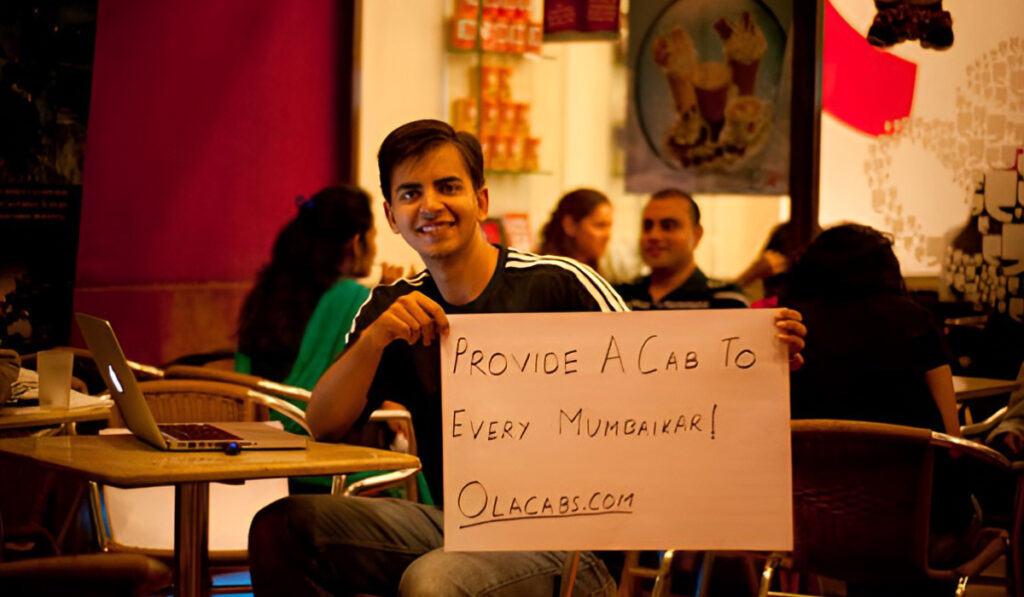
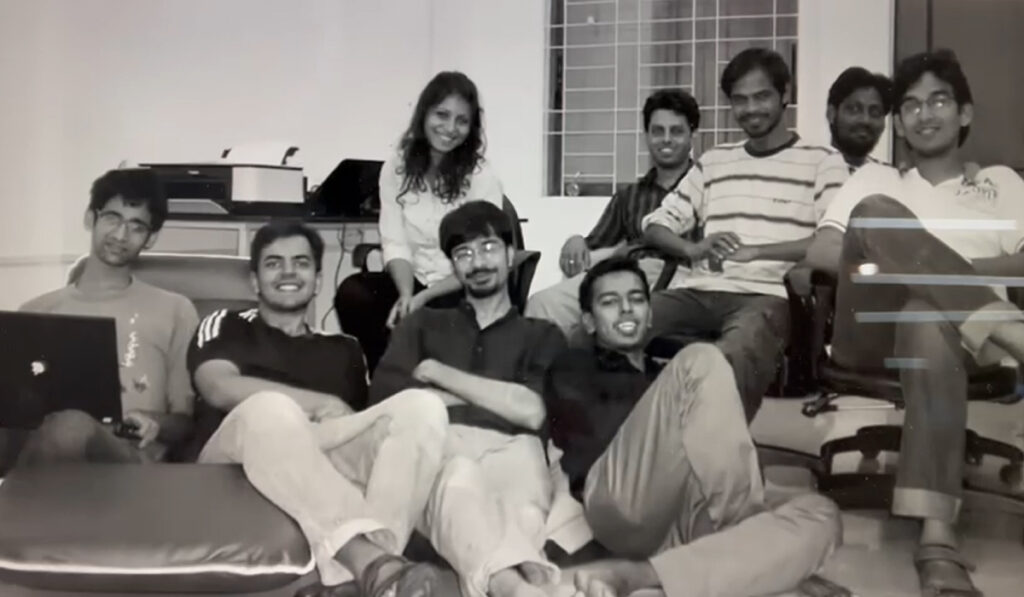
Ola revolutionised urban mobility by making it available on-demand for over a billion people across 3 continents. Today, Ola continues to move the world to sustainable mobility through its ride-hailing platform as well as through advanced electric vehicles manufactured at our Futurefactory. We are making the impossible possible with our upcoming Gigafactory, which we believe will be a significant leap in India’s journey towards sustainable and new energy vision.
The challenges that the world faces today like climate change, technology shifts, supply chain risks and others need fresh leadership and it is our moment in India to build these paradigms of the future! We are young, unencumbered by the past and full of energy and dreams for tomorrow! Our generation is destined to be the architects of change, shaping the future with resolve and purpose.
And at Ola, we are fully committed to make India the leader in technology paradigms of the future – energy, EVs, AI and digital tech. We will contribute towards the mission of making India a hub of these future technologies and are already creating very large businesses in all of these paradigms. We are building a full stack AI for India, we are developing advanced cell and battery technology, building next generation electric vehicles and redefining the future of logistics and commerce.
This ambition will take a generation to build but we will continue to dream the impossible, and then make it happen!
– Bhavish
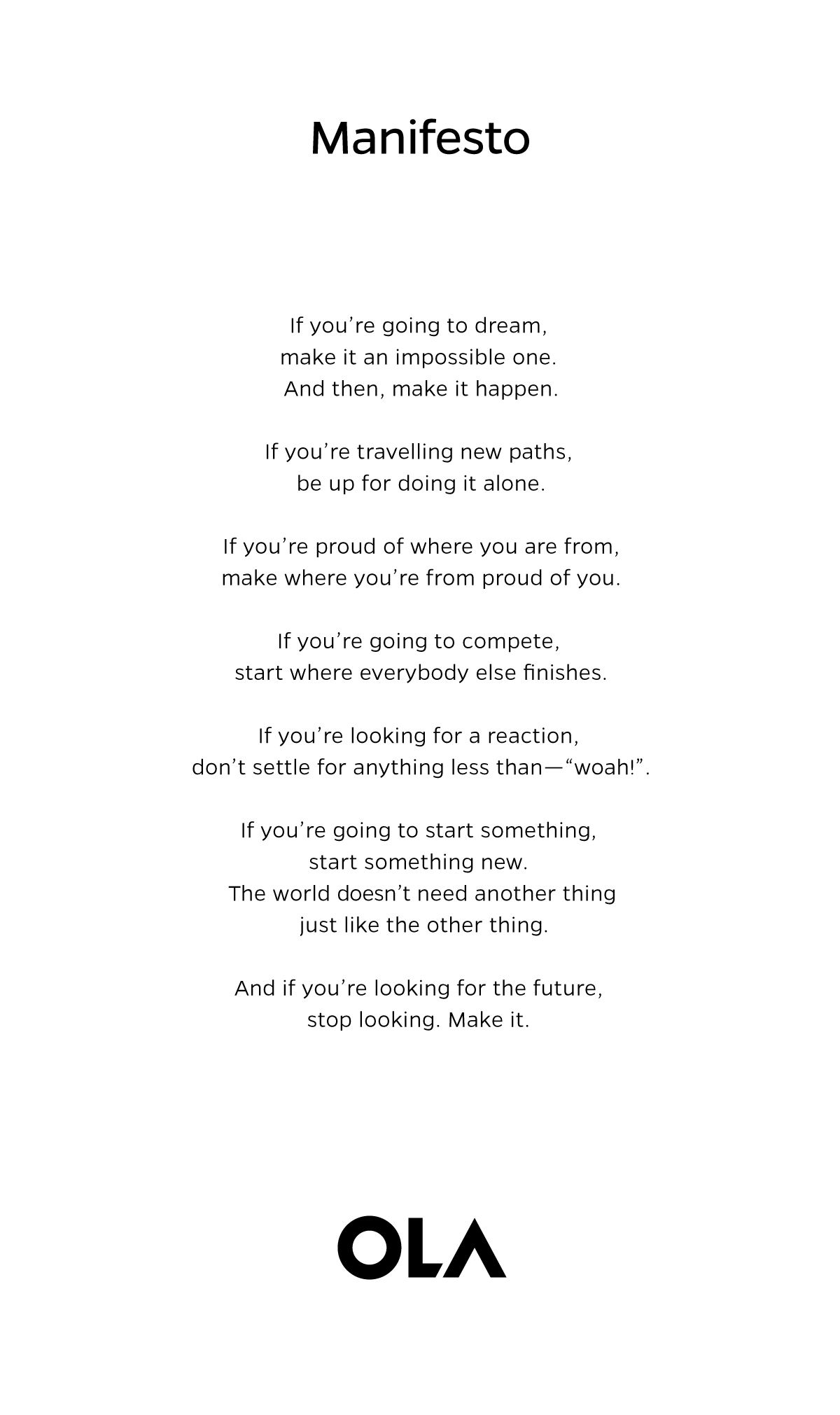
Flat 5% cashback on CRED UPI
Offer:
- Flat cashback of 5% up to INR 35.
T&C below:
- The limited-period promotional offer, namely the Ola offer (“Offer”) is provided to you by CRED.
- Offer is valid from 23rd January 2024 12 AM to 23rd April 2024 11:59:59PM.
- During the Offer Period, any customer who makes a minimum payment of INR 49 on Ola and chooses to make payment using “CRED UPI, will be eligible to receive a flat cashback of 5% up to INR 35.
- This Offer can only be availed by a customer once during the Offer Period. For any other transaction by the same customer in the same month, mystery cashback will be rewarded.
- The Offer is available only for payments made towards Ola via CRED UPI.
- The Offer is applicable only for a transaction that is successfully completed. A customer will not be eligible to receive the cashback under this Offer, if the transaction is canceled, for any reason whatsoever, by the customer, by CRED, or by the concerned Merchant.
- The cashback benefit will be provided instantly upon successful completion of the transaction, in the form of a CRED balance.
- The customer has to go to the rewards section in the CRED app and claim the cashback from the “cashback rewards” section. Customers can claim the cashback within 7 days from the CRED app.